- Land system
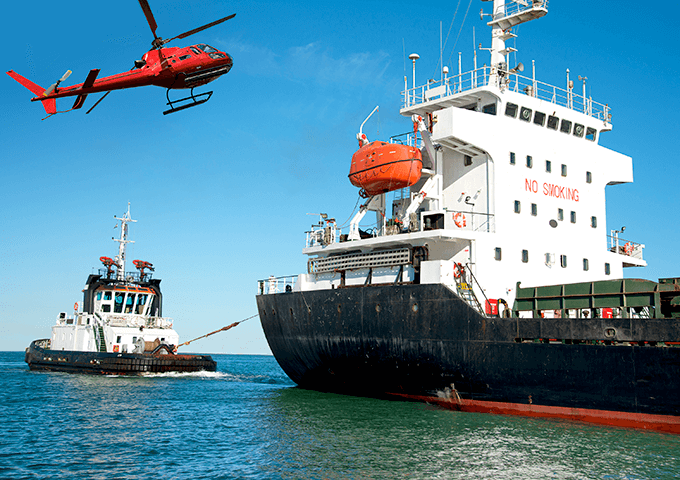
GMDSS coast station system that realizes stable operation and flexible expandability by IP multicast distributed control method.
- IP multicast radiotelephone control system.
- High reliability shown by long-term operation results in the Japanese domestic government offices, private businesses, etc.
- Started operation at Japan Coast Guard as its own system for Global Maritime Distress Safety System (GMDSS)
Introduction
What is a GMDSS*1Coast Station
A coast station is a radio station that communicates necessary information for ships to navigate safely over the sea from the land side. A coast station plays an important role in improving safety of ships and sea, such as various notifications for ships,
directional positioning, and communication using telephone functions.
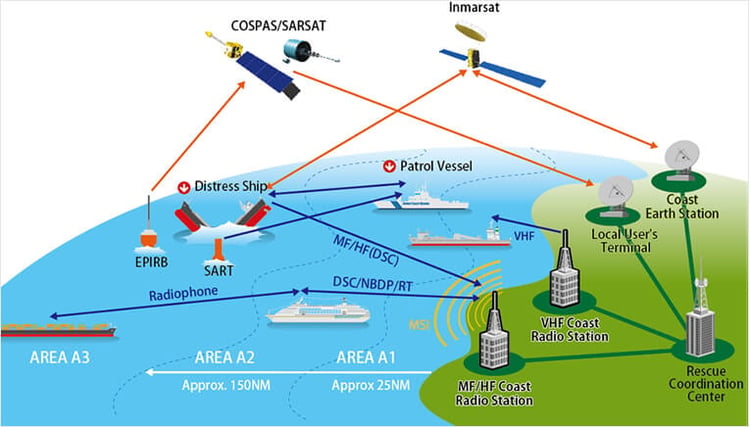
*1 GMDSS (Global Maritime Distress Safety System)
A global standard system for distress, emergency, and safe communications aimed at ensuring the safety of human life at sea. With the introduction of IMO in 1992, the global standard for safe navigation of ships was set, and the development was promoted in each country.
Overview
Issue of the 1st Generation IP Coast station system
In recent years, digitalization has become widespread in radio systems, and IP networking of communication lines has been widely used. In 2014, we released the IP network unified control system on GMDSS coast station system as the first generation of IP coast station system. In this system, we have realized flexible expandability with a simple device configuration by converting many of the components that were required in the past into software.
For a unified control method, it is necessary to make the server device redundant in order to solve the problem that all functions including voice calls would stop when a failure occurred in the server device. However, even in a system with a redundant configuration, there is a problem such as temporary downtime when switching server devices.
Evolution into the 2nd Generation IP coast station system
In 2021, the second generation of IP-based coastal station system has adopted the IP multicast distributed control system on GMDSS coast station system.
In this system, session control for voice calls and transmitting / receiving control of DSC messages, which were conventionally performed by server devices, are processed directly with the radio equipment by the distributed operation terminals using the IP multicast network.
As a result, even if a failure occurs in some of the constituent devices, the entire system can be continued without stopping, and downtime due to switching of server devices does not occur. In addition to the flexible expandability of the conventional IP coast station system, we have realized a more sophisticated IP coast station system.
High reliability due to long-term operational results
Since 2012, this method has been delivered as a core wireless system for the Japanese domestic government offices (Ministry of Land, Infrastructure, Transport and Tourism, public broadcasting companies, etc.) and infrastructure-related private companies (private broadcasting companies, road companies, gas companies, etc.), and it has been shown to be more reliable due to its long-term stable operational performance.
In 2021, it started operation at Japan Coast Guard (JCG) as its GMDSS coast station system.
Features
Stable Operating System
Conventionally in the unified control system, the server device controls the session between the operating terminal and the radio, and the voice communication of both devices is transmitted and received through the server device.
On the other hand, in the IP multicast distributed control system (the 2nd generation) , the operation terminal and the radio directly perform session control, and voice communication is directly transmitted and received between both devices by the multicast protocol. For DSC, the modulation / demodulation process is performed inside the radio, and DSC messages can be sent and received directly between both devices using the multicast protocol, enabling DSC operation even without a server device.
Furthermore, each component device distributes its own control / monitoring information by IP multicast in real time, so that all component devices always maintain a synchronized state.
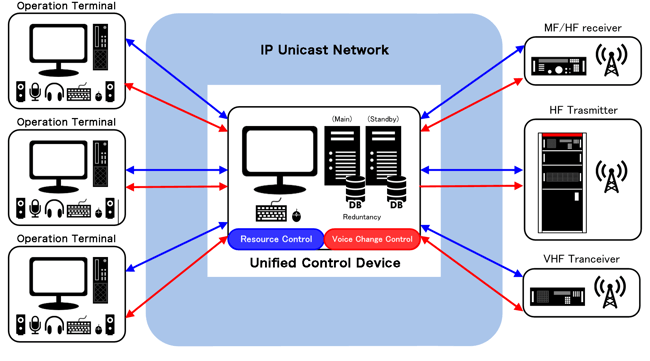
Unified control method (IP Unicast Network)
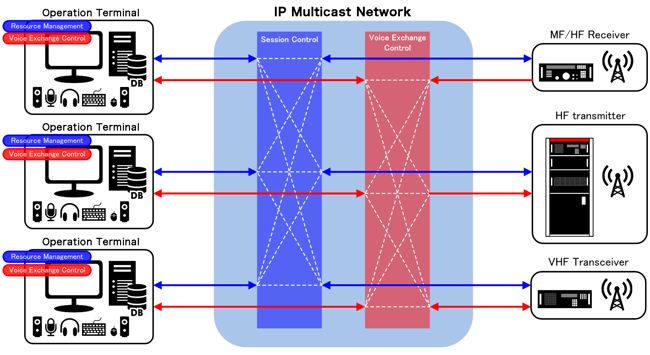
Distibuted control method (IP Multicast Network)
Flexible and expandable system configuration
By adopting IP multicast distributed control method , this system can be constructed with simple components such as operating terminals, radios, IP interface devices for radios, and VPN routers.
In this system, by controlling these communications over the entire IP network without arranging server devices that centrally control communications such as voice calls and DSC messages, each operating terminal and radio can transmit and receive necessary information simply over the IP network.
This allows these devices to be easily added over a wide area without physical restrictions. For example, even if the operation terminal of a certain communication station stops operating due to a failure, it is easy to operate the radio installed at the same communication station from the operation terminal of another station, and easy to temporarily add an operation terminal. Therefore, it is possible to respond flexibly even in an emergency.
In addition, this system has the IP network in a redundant configuration to suppress the influence of network failures, so that even if some operating terminal fails, they can always be operated from other operating terminals. Therefore, as a whole system, it is very stable as operation can continue without causing downtime if some failure happens.
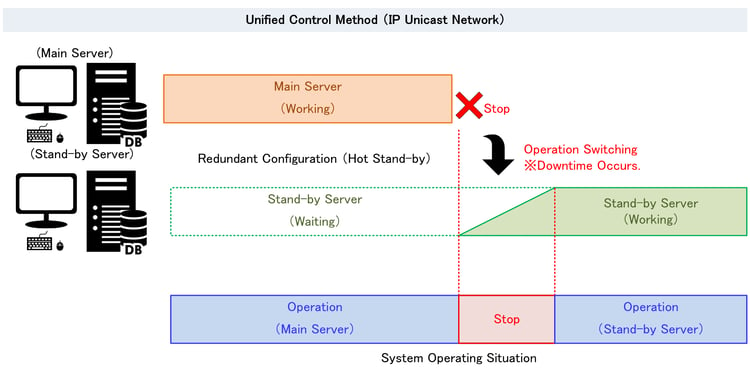
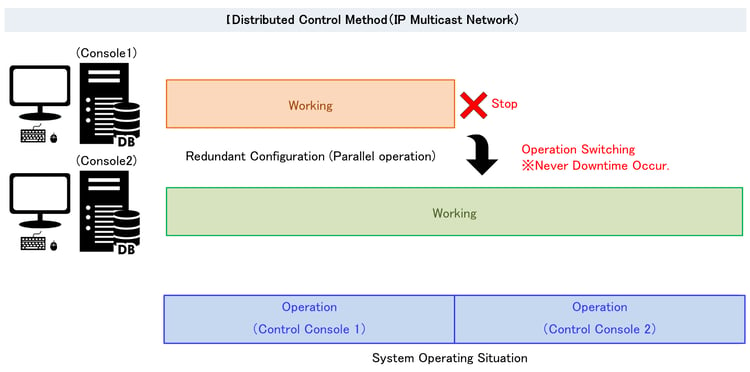
Versatile IP network construction
This system uses a VPN router to connect to an external IP network.
So, it is possible to build this system in various networks such as non-multicast networks, wide area VPNs, and wireless IP networks.
Furthermore, by connecting VPN routers using the VPN tunnel method, it can limit access to the system's IP network from the outside and enhance system security.
At the same time, the IP address system of this system can be set independently from the external network and existing network, IP design of this system can be changed without affecting the external IP network, so it is also excellent in maintainability.

Discontinued Products
Please note that some of the contents may have been changed or are no longer available.Please be aware of this in advance.



